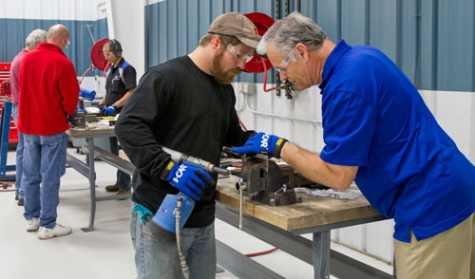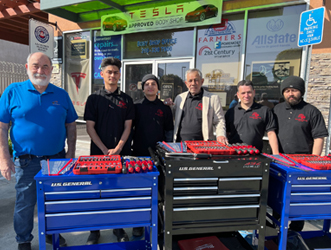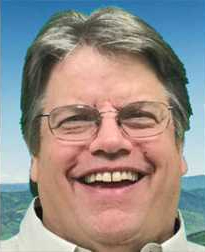When Nick Notte speaks to students across the country who are considering a job in the collision repair industry, he often shares his personal experience.
The current senior vice president of sales for I-CAR (Inter-Industry Conference on Auto Collision Repair) always had an interest in cars. He was able to turn that passion into a lifelong career and is now around vehicles every day.
“The feedback you get from these kids is tremendous,” said Notte. “You can truly change their minds and convince them that collision repair is a good way to go.”
Formed in 1979, I-CAR is dedicated to providing the information, knowledge and skills required to perform complete, safe and quality repairs. The not-for-profit organization provides a variety of educational and training recognition programs for the collision repair industry.
“I-CAR will soon offer 267 different courses to keep the industry on pace with technology innovation and skills development,” said Notte.
With a strong network of more than 1,600 volunteers, I-CAR has formed 189 committees that share information about the value of training in the industry. These volunteers are active in a local committee, all of which support and promote I-CAR’s mission.
“Knowing that the committees are as passionate as they are and knowing there is a technician shortage, we set some career goals for our committees,” said Notte.
Several of these goals are aligned with the work currently being done by the Collision Repair Education Foundation (CREF) to help encourage young people to pursue careers in the collision repair industry. I-CAR has a long history with CREF dating back to 1991 and works closely with the organization on many of its initiatives. Read about these initiatives in the previous Solving the Tech Shortage column.
One of the ways they work together is through the career fairs CREF organizes in major markets across the U.S. As the demand for career fairs continues to grow, CREF is asking I-CAR to organize local industry gatherings. This coincides with one of I-CAR’s committee goals—to complete a public-facing event, such as a career night at a local middle school or high school, a parade or NABC Recycled Rides gifting. The intent is to highlight the value of collision repair and promote I-CAR to the general public.
When you have knowledgeable and engaged collision repair representatives sharing information about the industry, Notte said it tends to make a difference. Volunteers are encouraged to plan functions where they can potentially have the youngest kids and their parents in attendance.
“We believe that to get to these collision repairers of the future, you have to get to their parents, and you have to get to the students at a very young age,” said Notte.
“Those parents and administrators who may not have listened to the message are all of a sudden listening to somebody who lives in their town, talking about his or her experience in the industry, and come to realize how acceptable it might be to have their kids work in the collision repair industry.
I-CAR’s industry partners are encouraged to attend the career nights in their local areas.
“We have OEMs that we work with through I-CAR’s sustaining partner program that are as passionate about helping with that technician crisis as we are,” said Notte.
I-CAR is approaching OEMs to possibly bring some “cool” vehicles to the career nights. Notte said the hope is that attendees will see the technology available, how the vehicles are constructed and begin to dream about how to repair them in a collision situation.
Another I-CAR committee goal is to have at least one member actively participate on a school advisory board at a high school or preferably middle school.
“That’s where you can affect the minds of those youngsters and the parents when you talk about collision repair, especially these days when cars are really cool,” said Notte.
Since many in this age group play video games and are keen on technology, he said they soon realize that with the technology in vehicles today, they can make a living doing what they enjoy.
Volunteers have found the school advisory boards to be extremely welcoming. Over the past few years, more parents and kids are looking at technical opportunities and increasingly requesting additional information about the collision repair field. Notte said this may be partially due to many kids now leaving college with a huge amount of debt and the lack of jobs available to reduce that debt.
I-CAR committee volunteers are also asked to identify one CTE (Career and Technical Education) school in their market that doesn’t already utilize I-CAR’s Professional Development Program (PDP)-Education Edition. Currently, 673 out of the approximately 1,000 career and technical schools in the U.S. are part of the I-CAR program, which was established in 2010 and formed to train collision repair professionals in essential role-relevant knowledge and skills.
The objective is to promote the PDP curriculum within the school, as well as initiate conversations about the technician shortage and the value of training technicians the “right” way.
“Our belief is that the right way is through the professional development program with specific roles identified and training delivered by that role,” explained Notte.
Ultimately, I-CAR would like to incorporate the PDP program into every career and technical school so technicians can be prepared to work when they graduate.
Committee volunteers also raise funds for CREF and secure donations of tools and equipment for career and technical schools. This year, each committee has been asked to complete one special event to support local schools, which can be held in coordination with any industry-related supplier or CREF.
Notte said these in-kind donations, such as welders, safety goggles and tools, make a significant difference because students are able to learn using the most recent equipment.
Often, collision repair instructors find that many students get discouraged when they are learning how to repair vehicles the way they were fixed 20 years ago.
“Most of those cars just aren’t on the road anymore,” said Notte. “When it comes time to fix the high-tech cars of today, they don’t see those come into the school.”
To help address this, some OEMs have donated brand new automobiles to these schools, so the students can see the technology first-hand and learn how to repair the vehicles.
“When you are talking about a young kid who is going to work on either the latest car coming down the pike or a 20-25-year-old vehicle, they get a lot more excited about working on that high-tech car,” said Notte.
His advice to body shops looking to hire future workers is to find those who love cars, and perhaps have a technical interest and then employ them as porters or apprentices for the summer. Through his experience, he has found that the kids in these roles are often hired upon graduation from high school or college.
He also said to pay close attention to see whether or not they have a desire to do this type of work. If the desire is there, Notte said training is readily available. For example, with the recent changes made to I-CAR’s PDP program, there is a subscription option for shops based on the number of technicians working at their facility. Students are allowed to take live, online and virtual classes for free and receive the same training as professional technicians. Not only does this offer them the opportunity to graduate with the Platinum designation, but it also helps gauge their interest in this field.
“If you have somebody who has an interest in the work and you think they might make a good technician, you can give them all of that I-CAR training for no extra charge,” said Notte. “At some point, if they are really good, you can bring them on and hire them.”
To ensure collision repair facilities have a clear understanding of the knowledge and skill areas needed to perform complete, safe and quality repairs, I-CAR has created an Automotive Collision Repair Industry Knowledge and Skills Protocol. The document outlines every knowledge area and skill necessary in a shop for technicians to be successful at their job. Shops can then identify the training skills needed by everyone in their business and then pinpoint the training to fulfill these requirements. The document can be accessed by visiting https://www.i-cartraintogain.com/protocol.
For more information about I-CAR and its training and initiatives, visit https://www.i-car.com/.














Stacey Phillips Ronak